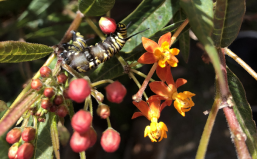We’re back with the next installment of Everything You Need to Know. In this series, we explore different terms and techniques used at Coastal Roots Farm. If you’re not sure what biodynamic farming means, or if you’re curious about the history behind Jewish agricultural practices, stay tuned.
(Got a topic you’d like to see covered? Leave a comment below!)
Because we are stewards and tenants of the land, rather than owners, we share our farm with others. These occupants include beneficial insects, from pollinators like bees and butterflies, to pests like gophers and aphids. Our land stewardship work involves managing pests rather than eradicating them.
In order to manage pests, we use a method called Integrated Pest Management, or IPM. IPM is a long-term pest prevention program that is aimed at controlling pest population through careful and management of the environment.
There are six steps we walk through when controlling a disease or pest issue:
- Identify: what is the pest, and what damage are they causing?
- Monitor and assess: How many pests are there, and how widespread is the problem?
- Set guidelines for when management action is needed.
- Prevent future pest problems.
- When action is needed, use a combination of biological, cultural, and physical/mechanical management tools.
- After action is taken, assess the effect of pest management.
On the Farm, we try to apply as little pesticide as possible. Even though we use all organic pesticides, we prefer to use close observation of our environment and crops as our first line of defense. Crops are monitored over time to assess their resiliency to pest infestation, during this time we are looking for beneficial insects to arrive. When we keep close tabs on pests or diseases, we can respond in a timely matter before too much damage is done.
An important component of IPM is planning resistant plant varieties. We also plant natural pest enemies. In the food forest, we recently used companion planting to keep gophers away. Adding yellow onions around young trees attracted beneficial insects that prey on tree pests and also deterred gophers, who don’t like the taste of onions. These are tools any home gardener can use to create an environment that favors crops and not the pest inflicting damage!
Action thresholds are another key part of IPM. When we observe a pest or disease, we set a threshold based on pest populations. If we find 5-10 aphids on an entire crop, for example, there’s no need to use controls. On the other hand, if we observe 5-10 aphids per plant on a crop, we’ve passed our threshold and need to take action. Setting these threshold gives farmers a clear understanding of what kind of disease or pest pressure their crop can handle. Before any action is taken it’s important to understand the pest pressure that is unique to the crop and the land. This information equips farmers to choose resistant plant varieties, giving them a competitive advantage before using any cultural controls.
When monitoring pests, we keep an eye out for beneficial organisms that are pest enemies. This step is critical to understanding pest populations and how much pressure a crop is under. If we notice a lot of lady bugs on a crop then we can rest easier about the number of aphids, knowing many of them will become lady bug food. In the event an infestation intensifies and the local beneficial insect population cannot combat the pest infestation, we will introduce beneficial insects to the areas to combat the pests.
Our last and final option is to use organic approved pesticides. Often these sprays are “cultures” that coat the leaves of plants. Bacillus thuringiensis is a common soil bacterium that we use to combat caterpillars. It works by being ingested by caterpillars and then hardens causing a toxicity in the caterpillar. Often, the bacteria become inactive after a few hours or days.
Home gardeners and farmers can apply these methods to their own crops. By combining all of these management approaches, you’ll have a set of tools and be better prepared to understand and solve any pest problems!
How do you manage pests in your own garden or farm?
